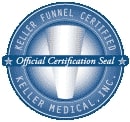There are several options as to where to make the incision. There is no single superior location; all have advantages and disadvantages based upon your anatomy, your tissue characteristics and the type implant selected. Whenever human skin is cut, a scar will form and nothing can change this biological process.

However, proper decision making and planning can result in a very acceptable scar in the vast majority of cases. The choice of incision is not just about where the patient wants their scar; it is also about, and maybe more importantly so, where the surgeon needs to make the incision so as to get the most satisfactory access to create a pocket for the implant that will yield the most ideal breast overall. This factor is again based upon the three factors cited above: anatomy, tissues and implant type. It is advised to discuss this important topic with your surgeon during your consultation.
What are the choices for incision location for surgery?
Incisions are made in inconspicuous places on the breast to minimize scar visibility. These incisions may be located:
Armpit (transaxillary) – To perform breast augmentation with a transaxillary incision, the incision is made in the natural folds of the armpit tissue. A channel is then created up to the breast. When utilizing this operative approach, I prefer to use an endoscope, or a small tube with a surgical light and camera embedded in the end, to provide visibility through the channel. The biggest advantage of breast augmentation with a transaxillary incision is that the scar is not on the breast. This works well with saline filled implants because they may be inserted through the small incision deflated and rolled up. Silicone gel implants require a larger incision to prevent damage to them during insertion, and for this reason I prefer to use only saline implants when using this surgical approach. This technique is limited to those patients who have little or no pseudoptosis. It is generally recommended NOT to place silicone gel implants through an armpit incision.
Crease on the underside of the breast (inframammary) – An inframammary breast crease incision is the most common incision used as well as the most versatile. Breast augmentation with an inframammary incision is performed with an incision made under the breast in the inframammary fold. The incision is made here to secure proper placement of the implant, but also to reduce scar visibility. When it is placed within the breast crease, or slightly above, it is barely noticeable, as the breast lies on top of the incision in most cases. An advantage of breast augmentation with an inframammary incision is that the surgeon works close to the breast, allowing for optimal visibility while working, as well as having the greatest degree of precision in pocket dissection and implant placement and alignment. This is also the approach of choice for women who have bottoming out of their breasts after pregnancy and lactation. This is critical in ensuring that the breast mounds are at equal height. Also, if affords the greatest accuracy in placement of teardrop implants, ensuring that the degree of implant tilt is symmetrical. This approach can also be performed with the least amount of postoperative discomfort.
Nipple (actually around the areola, the dark skin around the nipple – “periareolar”) – The goal of breast augmentation with a periareolar incision is to place the incision in the transition area between the dark areola and surrounding breast skin where it can be hidden. As with the inframammary incision, this incision allows the implant to be placed in precise pocket formation and provides for absolute controlled bleeding. The advantage to this approach is the small, hopefully near invisible scar. The problem with this approach is that if the scar is not invisible, it is now on the most visible portion of the breast. Unfortunately, no one can control the way you heal and scar, which is in your genetic makeup. This incision site is associated with an increased rate of capsule contracture due the fact that the milk ducts in the nipple are normally colonized with bacteria which can be associated with a low-grade infection of the implant resulting in a capsule contracture, or hardening of the breast.
Umbilical Saline implants may also be placed endoscopically through an incision in the navel. This is often referred to as a “minimally invasive” breast enhancement technique and is known as a transumbilical breast augmentation or the TUBA approach. I do not utilize this approach because the pocket is made by blunt dissection (which is actually in my opinion, a far cry from “minimally invasive”) rather than by direct visualization. This technique is fraught with more problems such as pain, bleeding and lack of precision. Also, the implant is usually placed above the muscle, which is not my preference. Don’t confuse the term “minimally invasive” from “small incision”. A transumbilical breast augmentation technique uses a small incision, but requires a lot of blunt dissection on the inside, which is not the same concept as a truly minimally invasive procedure such as a laparoscopic gall bladder removal, where a small incision is created to avoid cutting through the muscles of the abdominal wall. There is a big difference here. In summary, if a small incision requires more ripping, tearing and pulling of tissues to perform an operation, then there is nothing “minimally invasive” about it. THIS INCISION IS NOT RECOMMENDED IF SILICONE GEL IMPLANTS ARE TO BE USED.

